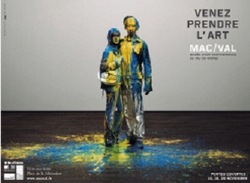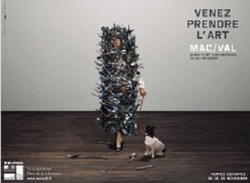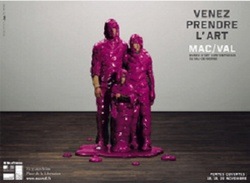 Le premier musée d'art contemporain en banlieue parisienne ouvre ses portes au public le 18 novembre 2005
Le premier musée d'art contemporain en banlieue parisienne ouvre ses portes au public le 18 novembre 2005
Le MAC/VAL, musée d’art contemporain du Val-de-Marne, situé aux portes de Paris, à Vitry, ouvre ses portes au grand public le vendredi 18 novembre 2005. Symbole d’une politique culturelle départementale forte et innovante et du soutien du Conseil général à la création contemporaine, l’ouverture d’un
© CLM BBDO/ Photo : ARNO BANI
nouveau musée d’art contemporain, en banlieue parisienne, constitue un événement majeur à vocation internationale.
A cette occasion, le public est invité à venir découvrir gratuitement le nouveau musée, sa collection et la première exposition, lors des journées portes ouvertes organisées les 18, 19 et 20 novembre.
Le MAC/VAL, construit par l’architecte Jacques Ripault, et labellisé « Musée de France », est le fruit et l’aboutissement de plus de vingt ans d’efforts menés par le Conseil général pour promouvoir l’art contemporain et favoriser sa rencontre avec tous les publics. Le Conseil général s’est engagé dans la réalisation de ce musée d’art contemporain pour permettre la mise en valeur d’une collection d’oeuvres d’art issues du Fonds Départemental d’Art Contemporain (FDAC). Le FDAC a été créé en 1982 à l'initiative du précédent président du Conseil général du Val-de-Marne, Michel Germa. Sa direction artistique était assurée par le journaliste et critique d'art, Raoul-Jean Moulin. Le Conseil général a conduit une politique active d’acquisitions depuis 1982. La collection est également constituée de nombreuses commandes d’estampes originales et du fonds Les Yeux fertiles, Suite Paul Eluard, composé de travaux sur papier confrontant le regard d’un peintre et l’écriture d’un poète.
Une collection d’art contemporain de plus d’un millier d’oeuvres reflétant la scène artistique en France depuis les années 50 jusqu’à la création la plus récente y est présentée. Lumière !, Action !, Paysages, la Vie moderne, ce qui nous entoure, ce qui nous façonne, Face au monde et Exister sont parmi les grands axes qui guident le visiteur. Ils l’invitent à une promenade muséale et architecturale où les plus jeunes artistes dialoguent avec les figures plus historiques de la scène artistique française. Ainsi Ange Leccia et François Morellet, Annette Messager et César, Valérie Belin et Peter Stämpfli, ou encore Malachi Farrell et Jacques Monory, se répondent, cohabitent, s’interrogent et nous racontent une histoire de l’art renouvelée.
Implanté en centre ville de Vitry-sur-Seine, à immédiate proximité de Paris, entouré d’un jardin public de 10.000 m2, cet équipement, signalisé par Ruedi Baur, est doté d’une surface de 13.000 m2 dont 4.000 m2 sont dédiés aux expositions permanentes et temporaires.
Le MAC/VAL accueille également un cinéma de 150 places, un centre de documentation de 380m2, la librairie Bookstorming, le restaurant Le Transversal, et des ateliers-logements qui permettront d’accueillir des artistes internationaux en résidence.
Ce projet (inscrit au contrat de plan Etat-Région 2000-2006) représente un investissement de 30,5 millions d’euros HT financé, pour moitié, par le Conseil général du Val-de-Marne et pour l’autre moitié par le ministère de la Culture et de la Communication et la Région Ile-de-France.
La première exposition temporaire réunira, en deux temps, deux artistes majeurs de la scène artistique française :
Jacques Monory, exposition Détour, du 18 novembre 2005 au 26 mars 2006.
Claude Lévêque, exposition Le grand sommeil, de mi-mai à début septembre 2006.
Jacques Monory, Détour (18 novembre 2005 - 26 mars 2006). Cette exposition invite Jacques Monory, artiste de renom, à investir l’espace des expositions temporaires du musée avec les moyens qui lui sont propres. Il s’empare de motifs issus de la culture dite populaire (musique, cinéma, romans policiers) en convoquant la narration et la fiction, et met en scène des scénarios fictionnels et autobiographiques. Jacques Monory propose un parcours qui réinvestit au regard de ses obsessions sa production artistique des années 60 à aujourd’hui.
Le second volet de cette exposition sera consacré à Claude Lévêque, Le grand sommeil (mi-mai - début septembre 2006), qui proposera une installation in situ inédite.
La campagne de communication pour accompagner l’événement
 A partir du 8 novembre, une campagne de communication inédite est déclinée en télévision (sur France 3 paris Ile-de-France Centre), au cinéma (salles de cinémas du Val-de-Marne et de l’est parisien, du 16 novembre 2005 au 4 janvier 2006), ainsi que dans la presse (différents magazines et quotidiens nationaux), par voie d'affichage (dans le métro et sur les panneaux d’affichage du Val-de-Marne et de l’est parisien) et sur internet (sites web du musée, du Monde et de Télérama).
A partir du 8 novembre, une campagne de communication inédite est déclinée en télévision (sur France 3 paris Ile-de-France Centre), au cinéma (salles de cinémas du Val-de-Marne et de l’est parisien, du 16 novembre 2005 au 4 janvier 2006), ainsi que dans la presse (différents magazines et quotidiens nationaux), par voie d'affichage (dans le métro et sur les panneaux d’affichage du Val-de-Marne et de l’est parisien) et sur internet (sites web du musée, du Monde et de Télérama).
© CLM BBDO / Photo : ARNO BANI
La campagne s’inscrit dans une démarche d’impression des émotions provoquées par l’art contemporain. Le slogan « Venez prendre l’art » invite le public à vivre au MAC/VAL un moment de découverte et de plaisir. Pour répondre de façon littérale à ce slogan, le film et les affiches mettent en scène des acteurs qui reçoivent réellement l’art en pleine figure puisque des litres de peinture ont été déversés sur eux.

© CLM BBDO / Photo : ARNO BANI
Fiche technique de la campagne de communication
Annonceur : MAC/VAL, musée d’art contemporain du Val-de-Marne, Conseil Général du Val-de-Marne
Responsables annonceur : Alexia Fabre, Marie Rotkopf, France Jouineau
Agence : CLM BBDO
Direction de la création : Pascal Grégoire / Anne de Maupeou
Equipe création : Frédéric Lutge (Concepteur-rédacteur), Dimitri Guerassimov (Direction artistique)
Réalisateur/ photographe : Arno Bani (auteur des photographies reproduites)
Equipe commerciale : Pascal Couvry, Julien Lemoine
Achat d’art - TV producer : Isabelle Baud
Production : Wanda
Musique : Coco Rosie
INFORMATIONS PRATIQUES
MAC/VAL
Musée d’art contemporain du Val-de-Marne
Place de la Libération
94400 Vitry-sur-Seine
T +33 (0)1 43 91 64 20
E contact (at) macval.fr
Site internet : www.macval.fr
Conservateur du musée : Alexia Fabre
Responsable de la communication : Marie Rotkopf
Horaires d’ouverture
Mardi, mercredi, vendredi, samedi, dimanche : 12 heures à 19 heures
Nocturne le jeudi jusqu’à 21 heures
Fermeture le lundi
Accès
En métro :
Ligne 7 direction Mairie d’Ivry
Arrêt Porte de Choisy
Bus 183 direction Orly Teminal Sud
Arrêt : Moulin de Saquet-Pelletan
RER C : Gare de Vitry-sur-Seine
Puis bus n°180 direction Villejuif-Louis Aragon
Arrêt: Moulin de Saquet-Pelletan
En Bus :
172, 180 et 183.





 Le premier musée d'art contemporain en banlieue parisienne ouvre ses portes au public le 18 novembre 2005
Le premier musée d'art contemporain en banlieue parisienne ouvre ses portes au public le 18 novembre 2005  A partir du 8 novembre, une campagne de communication inédite est déclinée en télévision (sur France 3 paris Ile-de-France Centre), au cinéma (salles de cinémas du Val-de-Marne et de l’est parisien, du 16 novembre 2005 au 4 janvier 2006), ainsi que dans la presse (différents magazines et quotidiens nationaux), par voie d'affichage (dans le métro et sur les panneaux d’affichage du Val-de-Marne et de l’est parisien) et sur internet (sites web du musée, du Monde et de Télérama).
A partir du 8 novembre, une campagne de communication inédite est déclinée en télévision (sur France 3 paris Ile-de-France Centre), au cinéma (salles de cinémas du Val-de-Marne et de l’est parisien, du 16 novembre 2005 au 4 janvier 2006), ainsi que dans la presse (différents magazines et quotidiens nationaux), par voie d'affichage (dans le métro et sur les panneaux d’affichage du Val-de-Marne et de l’est parisien) et sur internet (sites web du musée, du Monde et de Télérama). 

